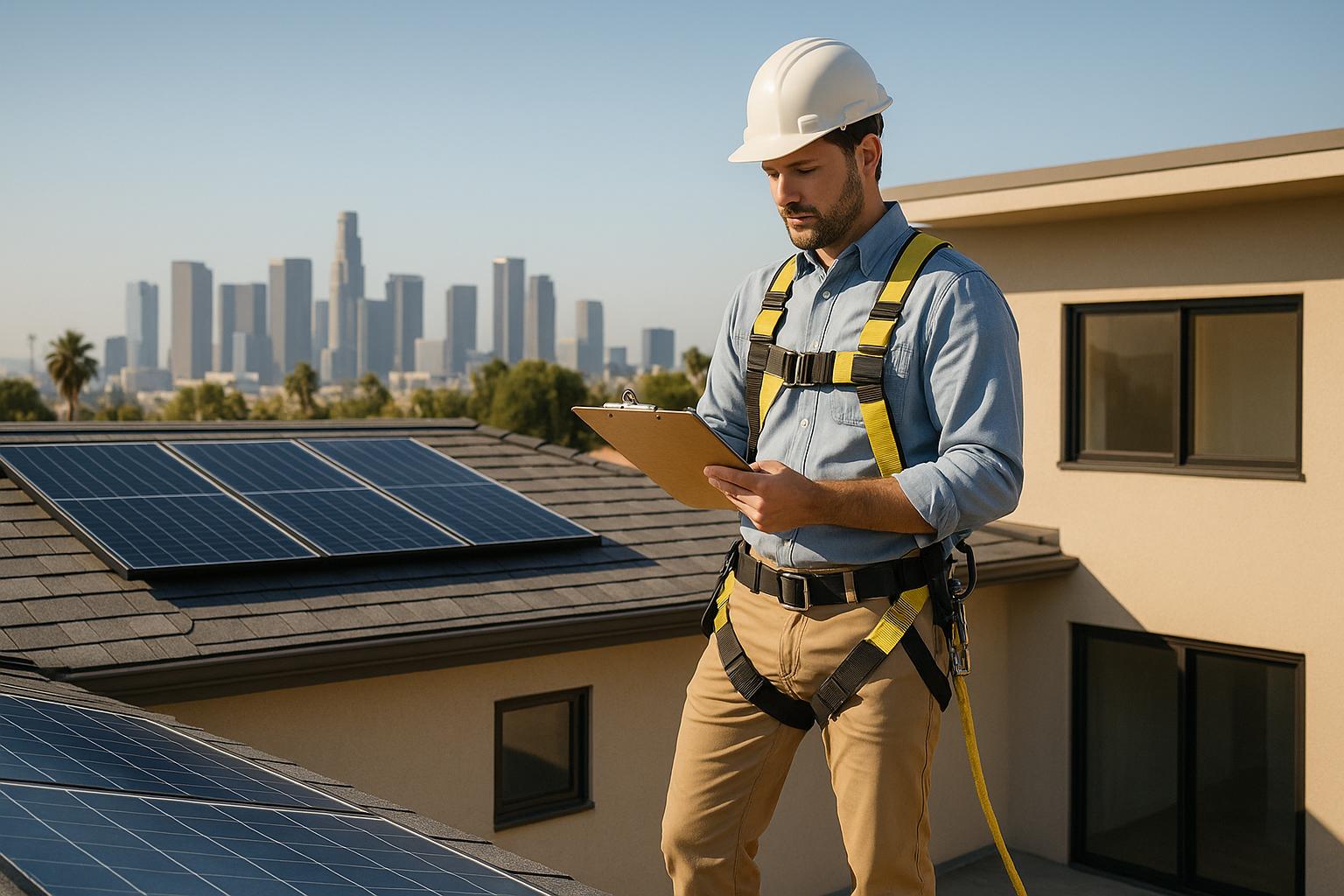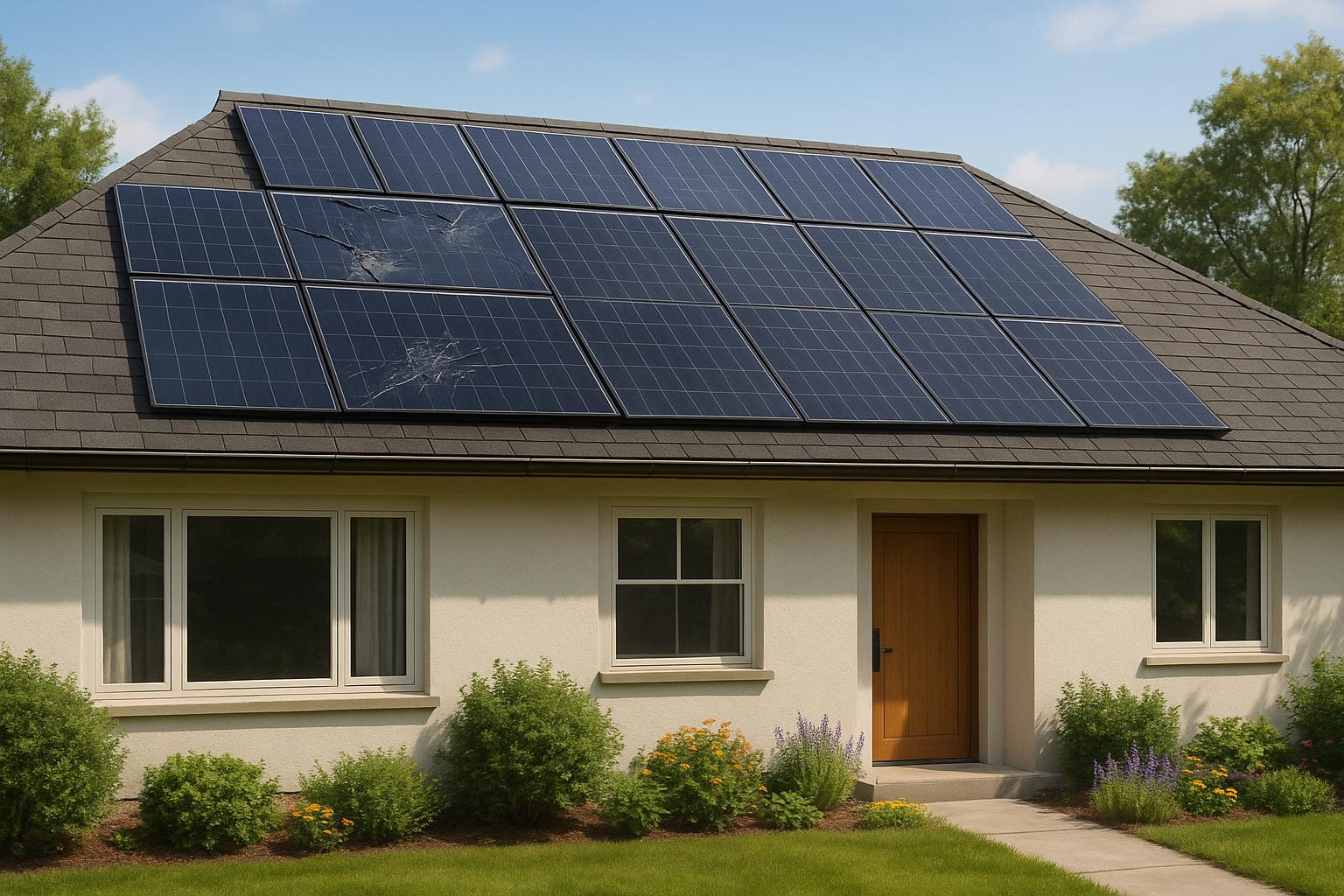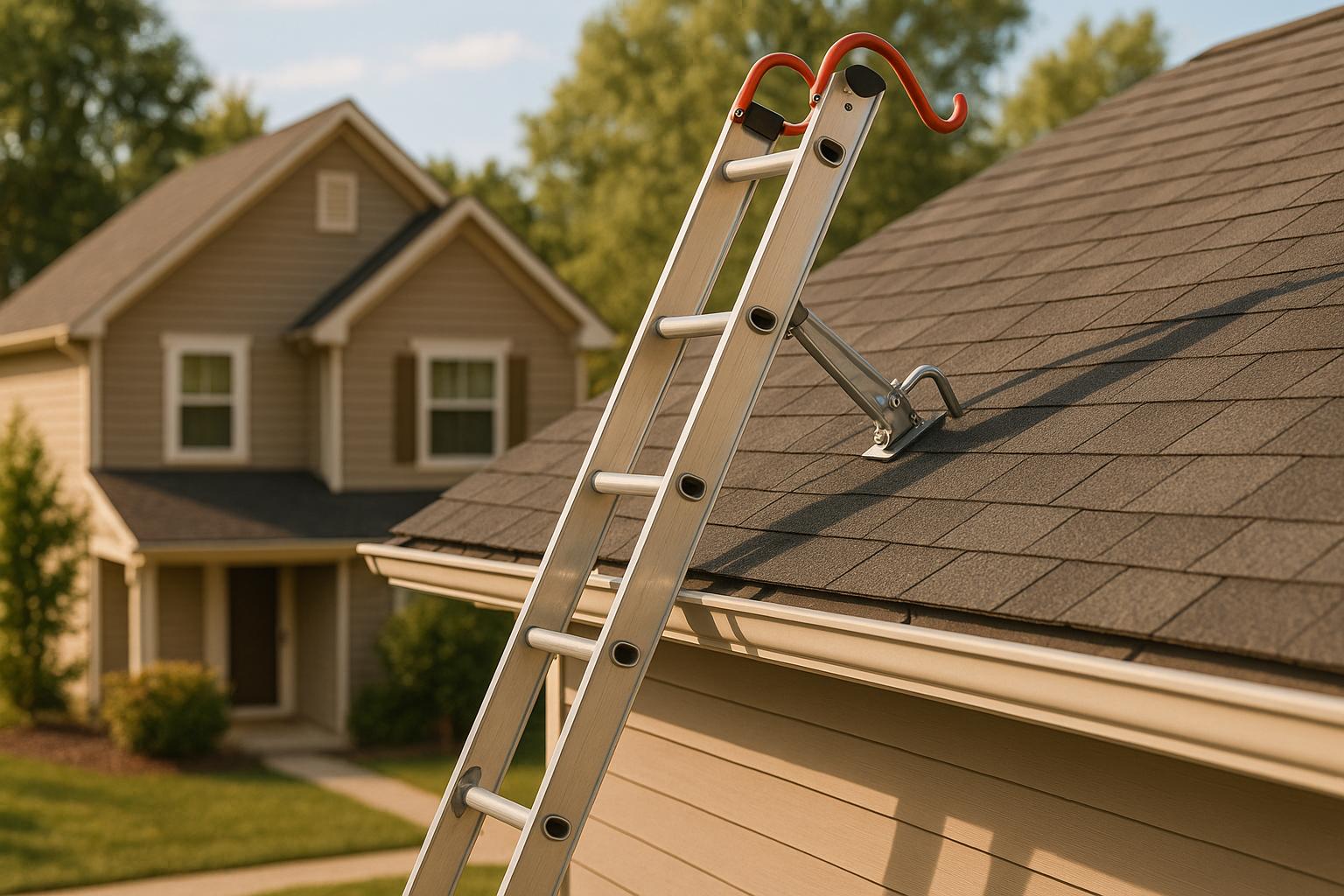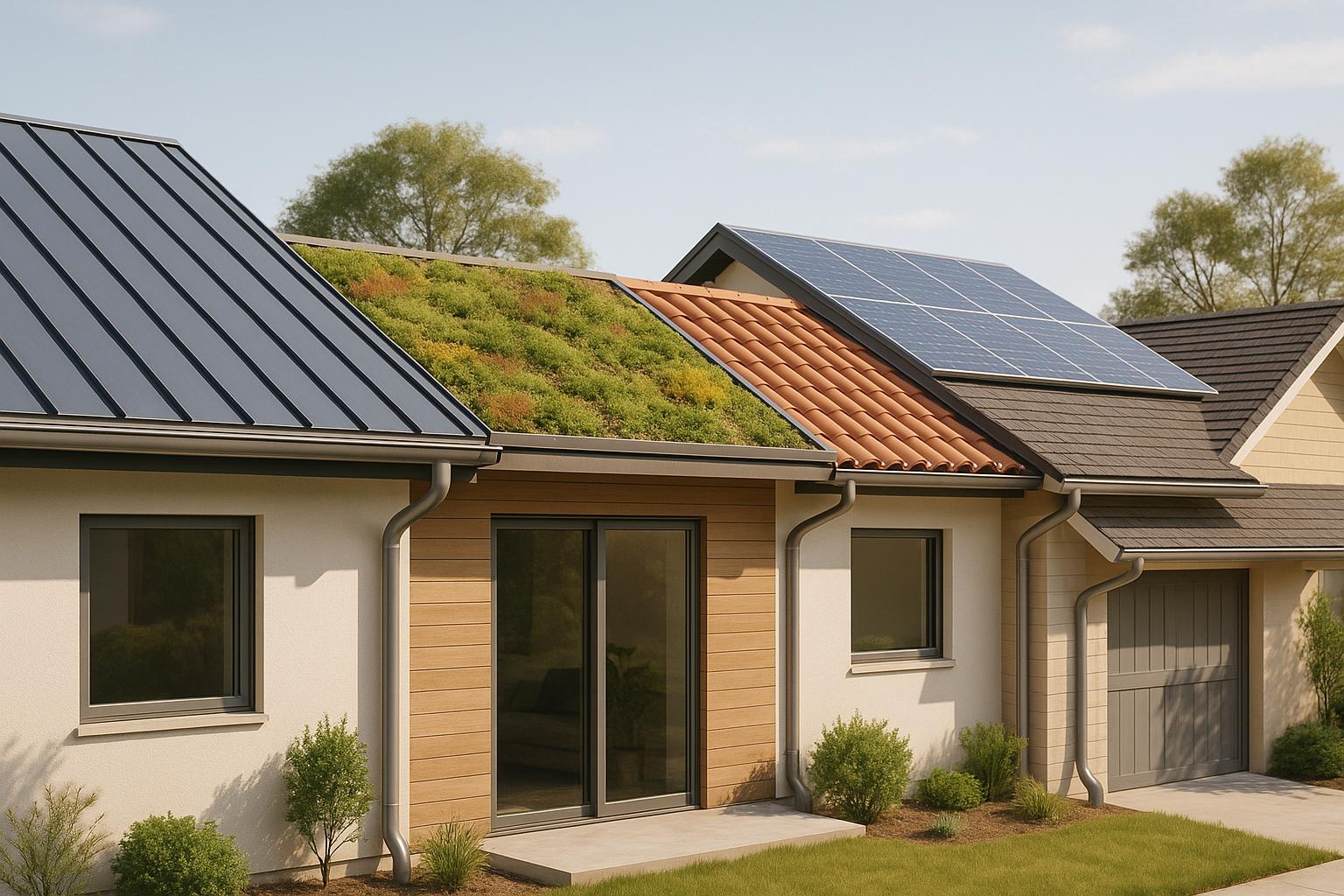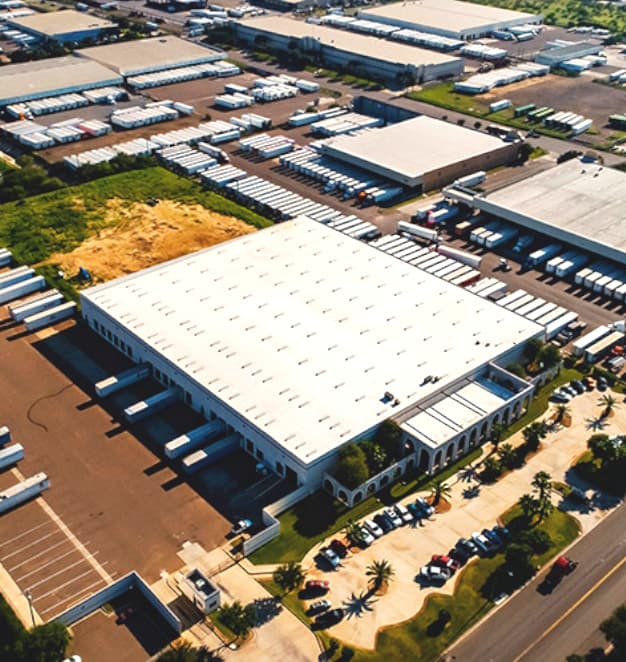If you own property in Los Angeles, roof inspections aren’t just about following regulations – they’re about protecting your investment and avoiding costly repairs. Here’s what you need to know:
- Why Inspections Matter: LA’s climate, with intense sun, rain, and winds, can damage roofs. Regular inspections help catch issues early, saving money and extending roof lifespan.
- Costs: Inspections typically range from $200 to $600, depending on property size and scope.
- Key Rules: The Los Angeles Department of Building and Safety (LADBS) enforces strict codes, including the "50% rule" for reroofing projects and mandatory cool roof standards for energy efficiency.
- Inspection Process: Inspectors check materials, installation, ventilation, and insulation using tools like infrared scanners and drones. Proper documentation (permits, plans) is required.
- Residential vs. Commercial: Rules differ based on property type. Residential focuses on safety and energy codes, while commercial inspections are more complex and costly.
Staying compliant with LA’s roof codes ensures safety, energy savings, and property value. Regular maintenance and professional inspections are key to avoiding major expenses.
Main Roof Inspection Rules in Los Angeles
Los Angeles has specific roof codes in place to ensure safety, energy efficiency, and compliance with environmental guidelines.
Building Codes for Roof Installation
The Los Angeles Department of Building and Safety (LADBS) oversees a range of codes that apply to roof installations and inspections. These include the Los Angeles Building Code, Housing Code, Electrical Code, Plumbing Code, Mechanical Code, and Green Building Code.
For any new construction, repairs, or alterations, building permits are mandatory to confirm that all work meets the required standards. Inspections are carried out at different stages of the construction process, ensuring that potential issues are addressed early and that the work adheres to current regulations.
Ventilation and Insulation Standards
Attic ventilation has been a requirement in Los Angeles since 1948, and the city enforces strict standards for both ventilation and insulation systems. These regulations call for balanced ventilation systems, which means intake vents (like soffit or eave vents) and exhaust vents (such as ridge vents) must be proportionate. The minimum ventilation area is determined by ratios of 1/150 or 1/300, depending on climate conditions and whether vapor retarders are used.
"Attic venting serves an important purpose and is key to a well-performing roof system."
- Joan P. Crowe, AIA, GAF‘s senior manager of codes and regulatory compliance
Power ventilation systems are required to deliver approximately 1.0 cubic foot per minute of airflow per square foot of attic space. Additionally, Quality Insulation Installation (QII) protocols ensure insulation is installed to meet specific R-values without gaps, voids, or compression. Care is taken to keep soffit vents clear and to protect openings from wildlife. In Climate Zones 6, 7, and 8, using a Class I or II vapor retarder allows the minimum ventilation area to be reduced to a ratio of 1/300.
California’s cool roof code further supports energy efficiency by setting standards for solar reflectance and thermal emittance.
California’s Cool Roof Code
California’s cool roof regulations require roofing materials to meet specific standards for 3-year aged solar reflectance, thermal emittance, or a Solar Reflectance Index (SRI) as outlined in the Los Angeles Green Building Code.
Roof Requirements by Pitch and Building Type
| Roof Type | Solar Reflectance | Thermal Emittance | SRI |
|---|---|---|---|
| Low-Rise Residential Low-slope (≤ 2:12) | 0.65 | 0.85 | 78 |
| Low-Rise Residential Steep-slope (> 2:12) | 0.25 | 0.85 | 20 |
| High-Rise Residential Low-slope (≤ 2:12) | 0.65 | 0.75 | 78 |
| High-Rise Residential Steep-slope (> 2:12) | 0.25 | 0.75 | 20 |
These regulations aim to minimize energy use and reduce the urban heat island effect. Cool roofs reflect more sunlight and absorb less heat, which helps lower indoor temperatures and cuts down on air conditioning costs.
The Cool Roof Rating Council (CRRC) certifies roofing materials, and all products must be rated through their system. If aged solar reflectance values are not available for a product, they can be calculated using the formula: Aged Reflectance = (0.2 + ß[pinitial – 0.2]), where ß is 0.65 for field-applied coatings and 0.70 for non-field-applied coatings.
There are exceptions to these requirements, including roof repairs, replacements covering less than 50% of the roof area, solar-equipped roofs, additions under 500 square feet, and roofs with thermal mass.
The Los Angeles Department of Water and Power (LADWP) offers rebates for compliant roofs. A base rebate of $0.20 per square foot is available, with an enhanced rebate of $0.60 per square foot for roofs meeting higher SRI thresholds. For low-slope roofs, the base SRI requirement is 78, while the enhanced rebate requires an SRI of 85. For steep-slope roofs, the respective SRI values are 20 and 35.
California is divided into 16 climate zones under Title 24, Part 6, with updates to energy standards occurring every three years. The next update is scheduled for 2025. These codes highlight the importance of aligning roofing practices with both safety measures and energy-saving goals.
How Roof Inspections and Testing Work
Roof inspections in Los Angeles ensure that your project complies with local codes and approved plans, helping you steer clear of delays and expensive fixes.
What Inspectors Check
Roof inspectors in LA focus on several key areas to confirm compliance with building codes. They check materials, installation processes, and structural elements to ensure they align with approved plans and permits.
For re-roofing projects, inspectors verify that existing or new solid sheathing is secure and properly fastened. Ventilation systems also come under scrutiny, as inspectors confirm vents are correctly placed and provide enough airflow.
Insulation is another major checkpoint. Inspectors ensure it meets required R-value standards and is installed without gaps.
Some of the most commonly inspected elements include foundation excavations, concrete work, wood framing, ventilation systems, plumbing, electrical setups, shear wall nailing, and roof nailing. In re-roofing, additional checks cover roofing materials, fire resistance, and sheathing.
To uncover hidden issues, inspectors use advanced tools like infrared scanners, moisture meters, and drones alongside traditional visual checks. Infrared scanners detect temperature differences that might signal trapped moisture or insulation gaps, while moisture meters locate hidden moisture in the roof, insulation, or structural components.
"Non-destructive Testing delivers a clearer, deeper picture of what’s really going on." – IR Analyzers
Drones equipped with infrared cameras are especially useful for inspecting large or hard-to-reach roofs safely. These tools and techniques help ensure your roof meets LA’s strict building standards.
Before scheduling an inspection, make sure you gather all the necessary documents to avoid any hiccups.
Required Documents for Compliance
Being prepared with the right paperwork is crucial when it comes to passing an inspection. A building permit is mandatory for any roof construction and must be secured before starting work. Permits can be obtained online via Los Angeles County’s Electronic Permitting and Inspection (EPIC LA) system.
During the inspection, property owners should have these documents on hand:
- The building permit
- Approved plans (if applicable)
- The building card issued with the permit
For re-roofing projects, inspectors will provide an inspection signature card during the first (or only) inspection. This card serves as proof that the work has been inspected and approved.
Inspection reports are also important. They confirm that the project meets current building codes and are often required for future property sales or insurance claims.
Different Inspection Methods Compared
Inspectors choose their methods based on the scope and complexity of the project. Here’s a breakdown of the most common approaches:
| Inspection Method | Best For | Advantages | Limitations |
|---|---|---|---|
| Manual Visual Inspection | Standard residential roofs, accessible areas | Direct evaluation of materials and workmanship, immediate feedback, cost-effective | Limited to accessible areas, weather-dependent, safety concerns on steep roofs |
| Drone Inspection | Large commercial roofs, steep or high roofs, initial assessments | Safe access to hard-to-reach areas, aerial coverage, photographic records | Limited in detecting internal issues, weather-dependent, less detailed on materials |
| Thermal Imaging | Energy efficiency checks, moisture detection, insulation issues | Identifies hidden problems, non-invasive, detects temperature variations | Requires temperature differences, costly equipment, needs expert analysis |
Manual inspections are ideal for identifying visible issues, while advanced tools like thermal imaging are better for spotting hidden problems. For most residential projects, traditional inspections remain the go-to method, as they allow inspectors to physically assess materials and installations and provide immediate feedback.
Thermal imaging, on the other hand, is particularly effective for uncovering moisture or insulation problems that aren’t visible to the naked eye.
The choice of method often depends on the complexity and value of the project. Skipping regular maintenance and thorough inspections can lead to hefty repair costs – potentially adding up to $200,000 over the lifespan of a roof. For large commercial properties, investing in comprehensive inspections can save money in the long run.
Post-Installation Inspections and Maintenance
After your roof is installed, the work isn’t over. To stay compliant with Los Angeles building codes and ensure your roof performs at its best, you need to focus on post-installation inspections and regular maintenance.
Final Roof Inspection Steps
The final inspection is a critical step before wrapping up your roofing project. It confirms that the work aligns with your approved plans and meets Los Angeles building codes.
During this process, inspectors check that materials, methods, and safety features match the permit specifications. They’ll catch common issues like damaged shingles, improper flashing, or ventilation problems that could have been overlooked. Make sure your contractor provides a warranty covering both materials and labor. Keep all related documents for future reference – they could save you headaches later on.
Once this inspection is complete, the focus shifts to ongoing maintenance to keep your roof in top shape.
Regular Inspection Schedule
Los Angeles weather can be tough on roofs. Intense sun, occasional heavy rains, and the Santa Ana winds all take a toll. Regular inspections are key to catching small problems before they turn into costly repairs.
"Regular roof maintenance is essential for LA homes due to the area’s variable climate. By detecting issues early, you can avoid costly repairs and guarantee your home remains durable and comfortable." – Roof Inspector Los Angeles
Plan to inspect your roof at least twice a year – spring and fall are ideal times – and always check it after severe weather like storms or high winds. Proactive maintenance can extend a roof’s life to an average of 21 years, compared to just 13 years for roofs that are only repaired when problems arise. Shockingly, over 80% of roofs are replaced too soon because minor issues weren’t addressed in time.
In between professional inspections, there are steps you can take to keep your roof in good condition:
- Clear gutters and drains to prevent water buildup.
- Remove debris and trim overhanging branches.
- Repair minor issues promptly.
- Ensure proper ventilation to manage attic temperature and moisture levels, which helps prevent mold and material deterioration. Without sufficient ventilation, attic temperatures can soar to 150°F, causing major damage.
Regular maintenance also pays off financially. A well-kept roof can boost your home’s value by up to 15% and deliver a 60% return on investment when it’s time to sell. Plus, energy-efficient upgrades like better insulation and reflective roofing materials can lower heating and cooling costs by 20% or more.
How Professional Roofing Companies Help
Professional roofing companies bring valuable expertise to the table. They understand LA’s strict building codes and can help ensure your roof stays compliant over time. Companies like Prime American Roofing specialize in navigating the city’s unique requirements and permitting processes.
These experts provide detailed inspection reports, complete with photos highlighting any issues. Many offer maintenance programs that include debris removal, drain clearing, and minor repairs, with costs typically ranging from $200 to $1,500 per year. Advanced tools like high-resolution cameras are often used for thorough inspections.
"Identifying structural weaknesses through inspections prevents leaks and promotes energy efficiency, reducing utility costs for Los Angeles homeowners." – Roof Inspector Los Angeles
Prime American Roofing, for example, offers free inspections and custom maintenance plans to keep your roof in peak condition. Their services are tailored to LA’s climate and regulations, protecting your investment for the long haul.
Routine maintenance tasks, such as sealing gaps and applying reflective coatings, can significantly cut energy bills – sometimes by as much as 30%. Protective roof coatings also extend the lifespan of your roof and improve its efficiency.
When selecting a roofing company for ongoing maintenance, look for one with strong local experience and a track record of satisfied customers. A trusted partner will not only help your roof meet LA standards but also safeguard your home and investment for years to come.
sbb-itb-d1d6490
Different Rules for Residential and Commercial Properties
In Los Angeles, the rules governing roof inspections differ significantly between residential and commercial properties. Knowing these distinctions is essential for property owners to stay compliant and avoid potential violations.
Residential Property Requirements
For residential properties, roofing must align with California’s building codes, focusing on safety and energy efficiency. While inspections aren’t routinely required, they become necessary during events like home sales, permit applications, or post-disaster evaluations.
Fire safety is a top priority for residential roofs in Los Angeles. Class A fire-rated materials are mandatory in wildfire-prone areas, and wood shake or wood shingle roofing is banned citywide. These measures aim to minimize fire risks in residential neighborhoods.
California’s Title 24 energy codes also play a crucial role. Residential roofing materials must reflect sunlight and limit heat absorption. Asphalt shingles, for instance, must meet a Solar Reflectance Index (SRI) value of at least 20 for new construction or reroofing projects.
Ventilation and insulation requirements vary based on property type. Unvented attics are allowed under certain conditions, such as being within the building’s thermal envelope and meeting specific insulation standards. Additionally, interior spaces must have heating systems capable of maintaining a minimum temperature of 68°F.
When inspections are required, the cost for a professional roof inspection typically ranges from $200 to $600. Some companies, like Prime American Roofing, offer free initial inspections for residential properties, providing homeowners with an upfront evaluation of their roof’s condition.
Commercial Property Requirements
Commercial roof inspections operate under a separate set of guidelines, focusing on structural integrity. These inspections are more intricate due to the diverse sizes, designs, and features of commercial buildings, as well as their unique utility systems and materials.
Flat roofs, common in commercial properties, must have a minimum slope of ¼ inch per foot to ensure proper drainage. This requirement addresses water management challenges specific to commercial structures.
Energy efficiency standards for commercial buildings mirror those of residential properties. For example, asphalt shingles in unincorporated areas of Los Angeles County must meet a 3-year aged Solar Reflectance value of 0.25, an initial thermal emittance value of 0.85, or an SRI value of 20.
Ventilation and insulation rules for commercial properties follow both the California Building Code and California Mechanical Code. These requirements are often more complex due to larger spaces, multiple HVAC systems, and varied occupancy types.
A commercial roof inspection involves assessing the roof surface for damage, leaks, or standing water, as well as inspecting interior ceilings and walls for water stains or mold. Inspectors also check flashing, HVAC systems, and drainage systems for proper function. Because of the complexity involved, commercial inspections take more time and cost more than residential ones.
Residential vs. Commercial Roof Inspections
The differences between residential and commercial roof inspections go beyond building codes, encompassing inspection processes, standards, and costs.
| Aspect | Residential | Commercial |
|---|---|---|
| Legal Requirements | Not generally mandated | Stricter compliance requirements |
| Standards | Standard Practice | ASTM Standard Guide |
| Focus | Safety and energy efficiency | Structural integrity |
| Cost | $200-$600 | Higher due to complexity |
| Roof Types | Mainly pitched roofs | Often flat roofs with slope rules |
| Fire Requirements | Class A fire-rated materials | Same fire safety standards |
| Energy Standards | SRI value of 20 for shingles | Same SRI requirements as residential |
Inspector qualifications also vary. Residential inspectors adhere to general Standards of Practice, while commercial inspectors follow the more detailed ASTM Standard Guide for Property Condition Assessments. This makes commercial inspections a specialized area within the industry.
The scope of inspections differs as well. While residential properties share similar designs, commercial buildings often require inspectors to understand specialized equipment, diverse business operations, and complex systems rarely found in homes.
Timing and frequency of inspections also vary. Residential inspections typically occur during sales or permit applications. In contrast, commercial properties often require regular inspections due to insurance, lease agreements, or regulatory obligations.
Prime American Roofing provides inspection services for both residential and commercial properties in Los Angeles, ensuring compliance with the city’s specific building codes. Their expertise spans single-family homes to large commercial facilities, addressing the unique needs of each property type.
Ultimately, commercial properties face more stringent inspection requirements, higher costs, and greater complexity. However, both residential and commercial properties must adhere to Los Angeles’ strict fire safety and energy efficiency standards, ensuring the safety of occupants and minimizing environmental impact. These differences highlight the need for tailored maintenance strategies and compliance planning.
Conclusion
Navigating Los Angeles roof inspection requirements is essential for protecting your property and ensuring safety over the long term. Regular inspections can help homeowners avoid repair bills that can climb above $10,000. Beyond just compliance, these inspections highlight the financial and safety benefits of adhering to local codes.
Los Angeles roofing regulations are detailed, covering standards like California’s Cool Roof Code and the use of Class A fire-rated materials in wildfire-prone zones. These measures are designed to reduce energy usage, lower fire risks, and extend the lifespan of roofs in Southern California’s challenging climate.
Inspection costs depend on the type of property. Commercial properties typically face higher costs due to their structural complexity and stricter codes. However, in both residential and commercial cases, proactive maintenance can lead to substantial savings over time.
Given the intricacies of these requirements, professional expertise is invaluable. Companies like Prime American Roofing simplify the process by offering free inspections and customized solutions. They ensure compliance with local building codes while enhancing roof durability and energy efficiency. With updates like the California Fire Code changes set for July 1, 2025, having expert support becomes even more critical.
From managing updates such as the California Energy Commission’s Title 24 revisions every three years to meeting insurance requirements, staying informed and partnering with experienced professionals safeguards your property’s value and your peace of mind.
FAQs
What documents do I need for a roof inspection in Los Angeles, and how can I prepare ahead of time?
To arrange a roof inspection in Los Angeles, you’ll need three key items: a valid permit, approved plans (if required during the permitting process), and a Building Card, which is issued when your permit is approved. It’s important to ensure that all permits are up-to-date and fully approved before scheduling the inspection.
To streamline the process, gather all necessary documents ahead of time and verify that nothing is missing. This preparation helps prevent potential delays during the inspection. If you’re uncertain about what’s required, reach out to your local building department for clarification and assistance.
What are Los Angeles cool roof standards, and how do they help homeowners save energy?
Los Angeles has implemented cool roof standards to boost energy efficiency by ensuring roofs reflect more sunlight and absorb less heat. This approach helps keep roof surfaces cooler, reduces the need for air conditioning, and combats the urban heat island effect. For homeowners, this translates into lower energy costs, less wear and tear on cooling systems, and a more comfortable home during scorching summer days.
Switching to a cool roof can lead to savings of 7% to 15% on cooling expenses, prolong the lifespan of HVAC systems, and support eco-conscious initiatives. These standards are part of the city’s broader commitment to conserving energy and encouraging greener living.
What are the main differences in roof inspection requirements for residential and commercial properties in Los Angeles?
In Los Angeles, the requirements for roof inspections vary between residential and commercial properties due to differences in their design and purpose. Commercial properties typically need more frequent and detailed inspections – usually twice a year. This is because they often have larger roofs, flat designs, and additional features like HVAC systems or solar panels that require extra attention. Residential roofs, being simpler in structure, generally benefit from biannual inspections for routine upkeep, though these are not always mandated by law.
The Los Angeles Department of Building and Safety (LADBS) provides guidelines for roof inspections across both property types. However, the exact requirements depend on the scope of the project and whether permits are involved. For both residential and commercial roofs, adhering to local building codes and maintaining proper ventilation and insulation are essential for passing inspections and ensuring the roof lasts as long as possible.

